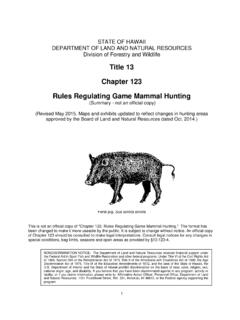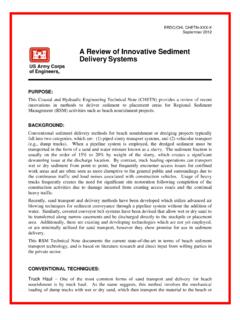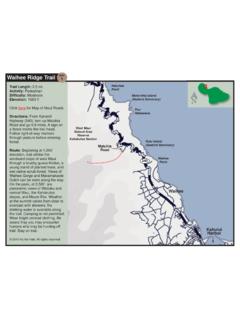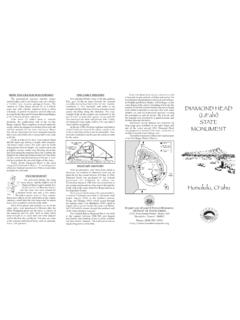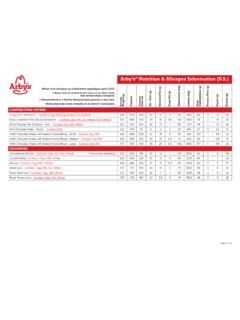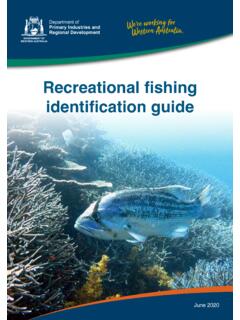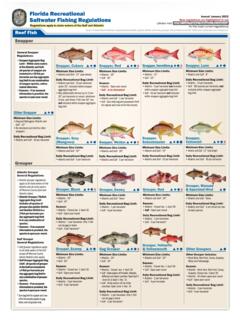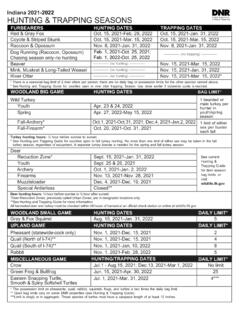Transcription of Fishing in Hawaii - A Student Manual
1 65 GOATFISHG oatfish are bottom-feeding carnivores,easily recognized by the pair of barbelsunder their jaws which are used to locatefood. Tucked under the sides of the jawwhen not in use, the barbels may not beimmediately apparent. Goatfish are com-mon in inshore waters, and are among themost popular food fish in m Parupeneus porphyreusWhitesaddle goatfishDescription: Juveniles greenish with redfins, body coloration becomes brick redwith age; white saddle behind soft dorsalfin; dark stripe running through eye fromnear snout to below first dorsal fin, darkerspot between eye and upper edge of : Length up to 20 inches; weight gen-erally up to 5 poundsHabitat: Various depths throughout reefareas, especially under coral headsFeeding: Nocturnal.
2 Mostly crustaceansSchooling: Small groups by day, solitaryat nightFishing methods: Spear, trap, net, hand-line, pole and lineSeasonality: Young k m common oninshore reefs throughout spring and sum-mer; adults common year roundK m are extremely prized fish in Hawaii ;the flesh is considered a to pleurostigmaSidespot goatfishDescription: Body light, whitish to pink;black spot on side below rear of first dor-sal fin, followed by large oval white : Length up to 16 inches; weight gen-erally up to 2 poundsHabitat: Sandy patches adjacent to coral,from nearshore to depths of about 120feetFeeding: Diurnal; small worms, crus-taceansSchooling: Adults solitary; juveniles smallgroupsFishing methods: Handline, spear, trap,netMoanoParupeneus multifasciatusManybar goatfishDescription: Reddish with shades of yel-low and white; black marks behind eye, atbase of pectoral fin, and black saddleareas in front of first dorsal fin, betweendorsal fins, below soft dorsal fin, and infront of tail.
3 Deepness of color varies withlight intensity, becoming lighter in : Length up to 14 inches; weight gen-erally up to 1 poundHabitat: Rocky areas, sandy bottoms nearcoral headsFeeding: Diurnal; crustaceans, small fishSchooling: Solitary or small groupsFishing methods: Handline, trap, spear,pole and lineMoano keaParupeneus cyclostomusMoana kali, blue goatfishDescription: Bluish-purple, with promi-nent yellow saddle at base of tail; slenderbody, long snout and long : Length up to 2 feet; weight general-ly up to 5 poundsHabitat: Rocky or reef areas, fromnearshore to depth of about 200 feetFeeding: Diurnal; small fish , crustaceansSchooling: Adults small groups; juvenilessolitaryFishing methods: Handline, spear, trap,net, pole and lineMunuParupeneus bifasciatusDoublebar goatfish, Joe LouisDescription: Reddish to yellowish-gray;black triangular saddle under each dorsalfin and near : Length up to 16 inches.
4 Weight gen-erally up to 3 poundsHabitat: Rocky areas, especially lavarocks, from nearshore to about 150 feetFeeding: Diurnal and nocturnal; smallfish, crustaceansSchooling: Solitary or small groupsFishing methods: Handline, spear, trap,net, pole and lineWeke , oamaMulloides flavolineatusWhite weke, yellowstripe goatfishDescription: Silvery white; yellow bandextends from eye to tail when schooling;band becomes less distinct when feeding,and a black spot appears below first dor-sal fin; very slender body compared withmost other : Length up to 18 inches; weight gen-erally up to 2 poundsHabitat: Sandy bottom areas near coralpatches; shallow water (to about 100 feet)Feeding: Nocturnal and diurnal; crus-taceans, wormsSchooling: Schools by dayFishing methods: Oama (juveniles)taken by pole and line; adults by net, trap,pole and line, spearSeasonality: Oama commonly found inshallow sandy areas during late summer.
5 Adult weke common year round Oama make excellent bait for papio andother predators, and are highly sought byshoreline ula, oamaMulloides vanicolensisRed weke, yellowfin goatfishDescription: Light pink with yellow hues;long yellow band extending from eye tobase of tail; fish becomes reddish whendead; inner lining of abdomen is : Length up to 16 inches; weight gen-erally up to 2 poundsHabitat: Reef areas, generally in depthsfrom 20-200 feetFeeding: Nocturnal; small worms andcrustaceansSchooling: Large schools during the day;solitary or small groups at night whenfeeding66 Fishing methods: Mostly net and trapSeasonality: Juveniles, known as oama,common offshore in late summer; adultscommon year roundWeke nonoMulloides pflugeriWeke ula, moelua, Pfluger's goatfishDescription: Red with vertical orange-yellow bands when alive; color changes touniform red when dead; inner lining ofabdominal cavity white; fairly robust com-pared with most other : Length up to 24 inches.
6 Weight gen-erally up to 8 poundsHabitat: Sand patches and limestone bot-toms, usually 60-300 feetFeeding: Diurnal; small fish and crus-taceansSchooling: Small groups or large schoolsFishing methods: Handline, trap, spearWeke pueoUpeneus weke, bandtail goatfishDescription: Light greenish above, fadingto white below; black and white horizontalstripes on : Length up to 12 inchesHabitat: Shallow sandy or muddy bottomsFeeding: Diurnal; crustaceans and smallfishSchooling: Small groupsFishing methods: Pole and line, net,spearWeke pueo should be prepared and eatenwith care, since the head may cause hallu-cinations and other symptoms of poisoningif (tangs) have blade-like spineson either side of the base of the tail, whichare sometimes used defensively by thefish.
7 (Fishermen have suffered cuts ontheir account, so surgeonfish shouldalways be handled with care.) Surgeon- fish are very common in inshore waters,feeding primarily by day, and at night rest-ing on the bottom in a sleep-like they are mostly plant eaters, having small mouths and specializedteeth, most surgeonfish are difficult tocatch with hook and unicornisBluespine unicornfishDescription: Dusky olive, with light blueon the fins and around the caudal spines;horn protruding from front of head abouteye level (lengthens with age). A similarspecies, Naso brevirostris, is grayishgreen with numerous small spots or darklines on the sides, and a body that is lessdeep.
8 Kala have two fixed caudal spineson each : Length up to 2 feet; weight general-ly up to 8 poundsHabitat: Inshore reef areas and alongrocky shoresFeeding: Diurnal; algae, especially moreleafy varietiesSchooling: Schools; large adults some-times found singly at edge of reefFishing methods: Net, spear, pole andlineKoleCtenochaetus strigosusGoldring surgeonfishDescription: Dark brown with about 35light blue horizontal lines extending intothe fins, small blue spots on the head,bright yellow ring around the eye; singleretractable caudal spine on each : Length up to 7 inches; weight gen-erally up to 1 2poundHabitat: Inshore reef areas, and depthsof 150 feet or moreFeeding: Diurnal, small bits of algae anddecaying plant materialSchooling: SolitaryFishing methods: SpearManiniAcanthurus triostegus sandvicensisConvict tangDescription: Silvery, may have yellowishtinge; six black vertical bars, the first pass-ing through the eye and the last near thebase of the tail; single small retractablecaudal spine on each : Length up to 12 inches.
9 Weight gen-erally up to 3 4poundHabitat: Most reef areas, from shore todepths of about 90 feetFeeding: Diurnal; mostly fine algaeSchooling: Large schools, but also seensingly or in small schoolsFishing methods: Net, spearManini are the most abundant surgeonfishin to Hawaii . Opelu kalaNaso hexacanthusSleek unicornfishDescription: Color varies from darkbrown to pale blue, with a dark blue tailfin; two fixed caudal spines on each : Length up to 2 feet; weight general-ly up to 3 poundsHabitat: Deeper waters outside reef; notcommon in waters less than 30 to 50 feetFeeding: Diurnal.
10 Plankton, including crablarvae and small wormsSchooling: Large schoolsFishing methods: Spear, net, pole andline67 PalaniAcanthurus dussumieriEyestripe surgeonfishDescription: Yellowish brown with blackspots, bright blue tail fin, fine blue lines onbody fading towards belly, yellow dorsaland anal fins, yellow band between andbehind the eyes; single white retractablecaudal spine on each side, surrounded bya patch of : Length up to 18 inches or more;weight generally up to 3 poundsHabitat: Mostly bays and outer reef areasover sandy patches, usually at depths ofat least 10 feetFeeding: Diurnal; algae and decayingplant materialSchooling: SchoolsFishing methods: Spear, trapPualuAcanthurus surgeonfish, yellowfin surgeonfishDescription: Purplish gray, sometimeswith irregular dark stri


